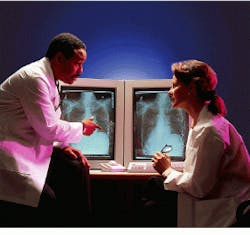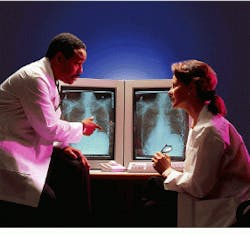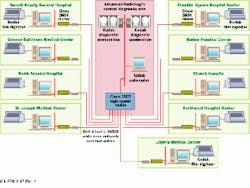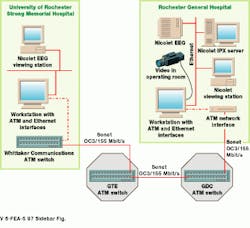TELERADIOLOGY USES wide-area networking TO SPEED REMOTE DIAGNOSIS
TELERADIOLOGY USES wide-area networking TO SPEED REMOTE DIAGNOSIS
By Lawrence H. Brown, Contributing Editor
For small hospitals and clinics, reducing the high cost of x-ray interpretation is crucial. With teleradiology, the cost of providing on-site radiologists can be reduced by using a central reading facility to interpret images. Such reading facilities can provide remote diagnosis either as a primary service or as a backup for local radiologists.
Two years ago, the American College of Radiology approved use of such systems for primary diagnosis. And, in a related demonstration, surgical teams from two hospitals have demonstrated that real-time remote electroencephalogram (EEG) monitoring is both effective and practicable (see "Telemedicine allows remote surgical consultations," p. 20).
Networks connecting from one to several hospitals and clinics to a single diagnostic center allow health-care companies to provide 24-hour diagnostic radiology. By eliminating the small hospitals` reliance on emergency-room doctors, teleradiology systems have reduced x-ray reading errors and increased the efficiency of patient care.
Linking sites
Advanced Radiology (Baltimore, MD) is a large radiology service that has 30 sites in the greater Baltimore area. As a merger of five independent radiology services, the company has integrated the Kodak Digital Sciences system from Eastman Kodak Co. (Rochester, NY) with telerouters from Cisco Systems (San Jose, CA) and communications systems from Bell Atlantic Telephone (Arlington, VA). In operation, the system transmits x-ray images over a wide-area network that links nine small hospitals to a central reading center where one radiologist interprets an average of 600 x-rays each night.
Each hospital is linked to the central site by a switched multimegabit data service (SMDS), an architecture that relies on TCP/IP addressing through public telephone networks. "We looked at other network addressing systems," says Greg Harris, systems engineer at Bell Atlantic, "but found IP ideal for transmitting images because it sends fewer overhead messages back and forth, a factor that can can slow throughput and reduce access to the network."
Using SMDS technology eliminates the need for installing dedicated lines from remote to central sites, while allowing Advanced Radiology to add remote sites on demand. "The SMDS operates like a telephone network," explains Joe Murray, a regional systems manager for Bell Atlantic. "The only difference is that you`re sending high-speed data."
Routing the data
At remote sites, a scanner from Lumisys (Sunnyvale, CA) digitizes x-ray film into a SunSPARC Ultra 10 workstation. Instead of illuminating an entire line or area and focusing the film image onto a CCD array, the x-ray scanner moves a laser spot across the film and captures individual pixel data and transfers them over an SCSI interface to the Sun workstation. Images are then viewed on a monitor and sent via an Ethernet hub to a Cisco 2501 router. This router connects the digitizer to the SMDS using a TCP/IP communications protocol.
From the SMDS, image data are sent to a Cisco Systems 7507 router in the teleradiology center. The router receives and switches data held in a buffer via a T-3 connection from the SMDS system. Once images are received, they are sent to a local-area network, again based on Ethernet, that directs x-ray data to one of two UNIX-based SunSPARC 10 workstations. Each Sun workstation supports two monitors from Data Ray (Westminster, CO) that are driven by an S-bus-based display controller from Dome Imaging Systems (Waltham, MA).
To ensure image consistency over time and between workstations, Dome`s display controllers have built-in luminance measurement and calibration software. Periodically, a photometer automatically measures the monitor`s luminance and creates the appropriate input-output gamma correction using an on-board look-up table on the display controller.
Software developed by Kodak allows images up to 2000 ¥ 2500 pixels to be displayed with 12-bit gray scale. Images can be windowed and leveled using an on-screen menu. Such operations can help compensate for over- or underexposed x-ray film and can be used to focus on a particular area of an image. Although the image quality of the digitized x-ray film is half that of conventional x-ray film, it provides enough resolution for emergency-case interpretation, which requires immediate attention.
Continued improvements in transmission speeds and image quality have encouraged wider uses for teleradiology. Some professional sports teams now use their medical facilities as remote sites, letting physicians consult with a specialist without requiring injured players to leave the stadium. Kodak`s teleradiology system, for example, was used in the 1996 Olympic Games in Atlanta, GA. Transmitting images gave medical staff members more time to attend to athletes on-site and spared them the time-consuming burden of passing through security checks to escort injured athletes to primary care centers.
In the future, teleradiology networking systems could transmit images directly to a radiologist`s home or office. Without a high-resolution monitor, image quality would be insufficient for primary diagnosis, but in many cases, it could still provide patient reference information.
A further incentive for adopting teleradiology is the goal of storing just one electronic patient record. "Some doctors log on to four different systems to find relevant patient data," says Karen Miller, vice president of sales and marketing for Dome Imaging Systems. "Eliminating disparate databases as part of an overall strategy to replace film with digitized x-rays will warrant an increase in teleradiology systems," she adds.
Thanks to digital teleradiology systems, diagnosis of patient data can be accomplished at remote sites (Image courtesy Kodak).
Using a high-resolution scanner, x-ray images can be transmitted from small clinics to remote hospitals for diagnosis by on-line physicians.
To send medical images over a wide-area network, Advanced Radiology chose a simple TCP/IP-based system. In operation, a switched multimegabit data service system switches data traffic from the hospitals at either 56-kbit/s or 1.5-Mbit/s T1 speed to 34-Mbit T3 speed, depending on demand.
Telemedicine allows remote surgical consultations
Future uses of telemedicine include real-time surgical monitoring and consultations from remote sites. Last year, Rochester Telephone (Rochester, NY), aided by General DataCom (Middlebury, CT), provided an ATM-based system that allows remote monitoring of neural and spinal surgery. Performed at Rochester General Hospital, the surguries were monitored by neurophysiologists at Strong Memorial Hospital (Rochester, NY). In addition to transmitting audio and image data over an asynchronous transfer mode (ATM) network, electroencephalogram (EEG) data could also be monitored remotely.
To do this, physicians used a specialized EEG instrument from Nicolet (Madison, WI) to monitor spinal and neural reactions during surgery. Attached to the patient`s foot or ankle, the device sends timed electrical pulses up the spine to the patient`s brain. Electrodes attached to the patient`s forehead capture this analog data, which are then digitized and transmitted over an Ethernet hub with the video and audio data to an ATM switch.
Data are sent to a final ATM switch at the monitoring site and transmitted to a second Ethernet hub. Here, video, audio, and EEG data can be monitored simultaneously. Using a Nicolet viewing station, the neurophysiologist can monitor EEG waveforms at critical times.
"Neurophysiologists are needed only at intermittent times during these operations," explains Dr. Michael Berg, assistant professor of neurology at Strong Memorial Hospital. "Bringing the data to the physician frees up surgeons with busy practices and allows teaching hospitals more access to such procedures."
Berg believes that in the future, neurophysiologists will be able to monitor as many as 12 surgeries at a time. "Ideally, central monitoring stations will be set up on a regional basis to let smaller hospitals that do not have expensive hardware perform complex surgical procedures," he says.
L. H. B.
Audio, video, and electroencephalogram data transmitted over ATM networks allow physicians to remotely monitor neural and spinal surgery.




